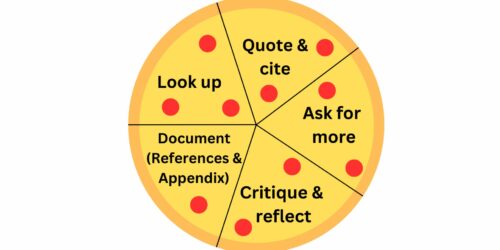
AI Savvy Rubrics for Writing Assignments
By Elan Paulson and Ada Sharpe
Rubrics can reinforce expectations about how to use or not use generative AI (AI) in writing assignments. This post provides ideas and examples for writing rubrics that discourage or encourage AI use.
Communicating Your Goal with a Rubric
Clarifying whether you discourage or encourage AI use is the first step when designing rubrics. If you aim to discourage AI use, focus on fostering human capabilities such as critical thinking, creativity, and writing contexts. If the aim is to encourage student AI use, guide students on using AI tools to support or enhance the writing process and address undesirable features of AI outputs. Regardless of your level of permitted use of AI, keeping the learning outcomes as the focus of the criteria items is essential.
Reflection Question: Is your assignment designed to encourage or discourage AI use? What key reasons might you want to encourage or discourage AI use related to your course outcomes?
Discouraging AI Use: Poor Standard and Assignment Contexts
AI tools can produce highly structured content and “error-free” drafts. Use rubric items to focus on elements of writing in which AI outputs are poor or substandard. Here are some sample items relating to the poor standard of writing that AI tends to generate.
- Information accuracy (inaccurate content will not meet the minimum standard)
- Verifiable references (hallucinated references will not meet the minimum standard)
- Language, voice, and style (embellished, flowery, exaggerated language will not meet the minimum standard)
- Emphasis on nuance or complexity (lack of addressing nuance or complexity will not meet the minimum standard)
Also, rubric criteria may discourage AI use by requiring students to write within a specific context, using specific course materials, or in a specific process that AI cannot easily access. Depending on your course outcomes and how your writing assessment is designed, you may wish to include one or more of these sample items.
- Connections to course material (vague, inaccurate, or general attempts to connect to specific course materials will not meet the minimum standard)
- Connections to hyper-local issues or organizations (vague, inaccurate, or general attempts to relate to a specific issue, organization, current event, etc., will not meet the minimum standard)
- Evidence of progression (limited or incomplete evidence of drafts, notes, outlines etc., do not meet the minimum standard)
- Class activity or discussion synthesis (a limited, inaccurate, or incomplete reference to class activities or discussion will not meet the minimum standard)
- Application of human feedback (minimal application of specific peer or faculty feedback will not meet the minimum standard)
Other checklist items to discourage AI use
Where evaluation criteria are not directly related to the learning outcome, or when there may be the chance of a “false positive” concerning the suspected use of AI, you may wish to use an additional checklist grading tool for aspects of writing that may appear to resemble AI use. Examples include:
- Over-structured writing, e.g., bulleted lists
- Missing or falsified content
- Artifacts of tool use, e.g., Prompt words
- Popular AI terms, e.g., “tapestry”
Reflection Question: What indicators can you use in your rubric or checklist to distinguish between human and AI-generated writing?
Encouraging AI Use: Integration, Evidence, and Critical Thinking
If AI use is encouraged to support writing tasks, you may wish to focus on the clarity and effectiveness of the writing, regardless of AI assistance. Also, rubric criteria may focus on how students document, cite, and reference AI use. Rubric criteria can also evaluate how students describe their personal insights and reflect critically on their use of AI in the writing process.
Rubrics that encourage AI use should clarify the qualities of effective writing in the context of AI assistance. This approach prepares students to use these tools responsibly and transparently.
Here are some sample items relating to encouraging guided and appropriate use.
- AI use citations and references (if AI is used but not cited and referenced, it may not meet minimum standards)
- Evidence of AI use (if evidence of AI use is still in the writing, it may not meet the minimum standard)
- Critical reflection on the ability to engage with AI outputs, integrate AI-generated ideas with personal insights, and use AI tools ethically (if there is a limited or general reflection on how tools were used, it may not meet minimum standards)
Important Note: the analytic rubric items in the “Discouraging AI use” section above may also encourage AI’s purposeful and appropriate use in students’ writing assignments.
Other checklist criteria to encourage guided AI use
Where criteria are not directly related to the learning outcome, students are asked to follow specific AI-assisted writing processes and use a checklist to encourage appropriate AI use. Examples may include:
- Guidelines compliance, e.g., follows established AI permitted (and not permitted) use guidelines
- Privacy and security measures are taken, e.g., the use of Conestoga’s Copilot
- Completion of an AI use template or checklist
- Disclosure of required AI practices, e.g., screenshots, prompts, or outputs
Reflection Question: What rubric or checklist items can guide students to use AI tools ethically and effectively in their writing?
Download: AI Savvy Rubric Criteria Examples
The document “AI-Savvy Rubrics Criteria Examples” provides a repository or bank of sample analytic and checklist rubric criteria to select/customize in order to support your expectations for AI use. Select to download:
Final thoughts
Rubrics are only one way to communicate your expectations for using AI with academic integrity. Ensure that you communicate your expectations in writing, especially if you wish for students to use AI. Describing why AI is discouraged and encouraged and giving students time to ask questions and practice with permitted writing strategies can help students understand the assignment’s goals.
References
References
Adapted from Curricu.me. (2023). An AI Detection Rubric. Infographic.
Scurr, C., & Bleaney, R. (2024, November 26). Investigating Potential GenAI Use (EDV0328 – Section 1 of Fall 2024) [Workshop]. Conestoga College, Academic Integrity Office. Online synchronous.
AI Disclosure
The image for this post was generated with Mistral.






